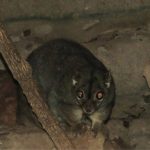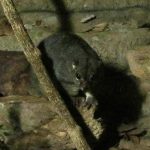ROCK-HAUNTING RINGTAIL POSSUM
The Rock-haunting Ringtail Possum: Guardian of the Rocky Outcrops
Imagine a moonlit night in Australia’s arid heartland, where the ancient sandstone cliffs hold secrets older than time itself. Among these rugged landscapes, a rarely seen creature stirs—a master of the rocks, the Rock-haunting ringtail possum.
Habitat: Nature’s Fortress
The Rock-haunting ringtail possum is a specialist, found almost exclusively in:
- Rocky habitats: gorges, escarpments, and craggy outcrops
- Geological preference: sandstone and quartzite formations
- Geographic range: arid and semi-arid regions of Western Australia, the Northern Territory, and South Australia
These landscapes are visually striking. Picture steep, ochre-hued walls glowing at sunset, pockets of hardy vegetation clinging to cracks, and the air filled with the dry, earthy scent of ancient rocks warmed by the day’s sun.
Adaptations: Built for the Rocks
Survival in such a harsh environment requires ingenuity. The Rock-haunting ringtail possum is equipped with several remarkable features:
| Adaptation | Description |
|---|---|
| Specialised foot pads | Textured pads provide exceptional grip, enabling agile climbing on stone |
| Prehensile tail | Acts like a fifth limb, helping balance and maneuver through rocky crevices |
| Nocturnal behaviour | Active at night, avoiding daytime heat and predators |
| Sheltering habits | Hides in rock fissures, tree hollows, or leafy nests during the day |
Imagine the tactile sensation of gripping cool, rough sandstone with nimble toes, and the reassurance of a strong, flexible tail as you weave through a labyrinth of boulders under a canopy of stars.
Diet: A Taste for the Tough
Despite the challenging environment, these possums are resourceful feeders. Their diet features:
- Leaves: especially from acacia and eucalyptus trees
- Native flowers and fruits: seasonal treats adding variety and nutrition
- Spinifex grass: a tough, spiky plant common in arid regions
As they forage, the air is filled with the subtle aroma of eucalyptus oil and the gentle rustle of nocturnal life.
Behaviour: Night Watchers
The possum’s life is a story of caution and adaptation:
- Nocturnal foraging: They emerge after sunset, moving quietly in search of food
- Daytime refuge: Tucked away in cool, narrow crevices, they escape the harsh sun and keen eyes of predators
- Social structure: Often seen in small family groups, using soft vocalisations to communicate in the stillness of the night
Conservation: A Call for Action
Despite their ingenuity, these possums face mounting challenges:
- Habitat fragmentation: Expanding human activities have split their populations and reduced safe habitat
- Declining numbers: The species is now listed as a priority for conservation, especially in Western Australia
Why Their Survival Matters
Every species is a thread in the web of life. The Rock-haunting ringtail possum is not just a marvel of adaptation; it helps maintain the balance of its fragile ecosystem. Its disappearance would mean the loss of a unique chapter in Australia’s natural story.
Guardians of the Ancient Rocks
The Rock-haunting ringtail possum is a testament to nature’s creativity, thriving where few others dare. By understanding and valuing such species, we ignite a sense of wonder and responsibility. The future of these shy guardians rests not only on continued research and conservation, but also on our shared commitment to protect the wild places they call home.
How You Can Help
Learn more, spread awareness, and support conservation efforts—even small actions can ripple outward, helping ensure that Australia’s rocky outcrops continue to echo with the gentle presence of the Rock-haunting ringtail possum for generations to come.


